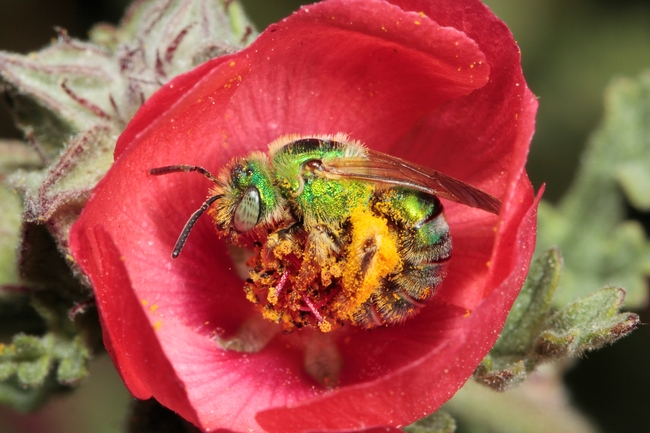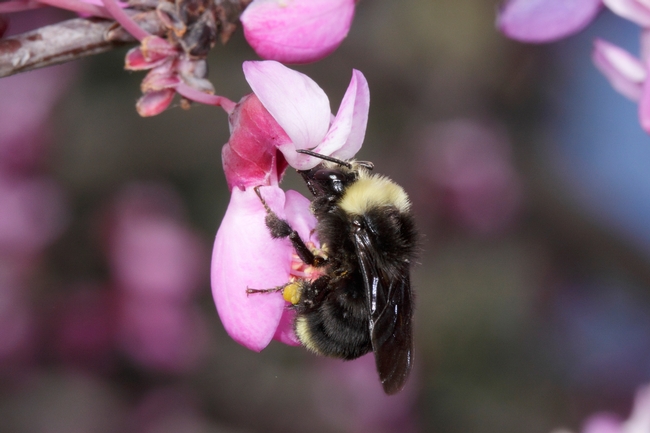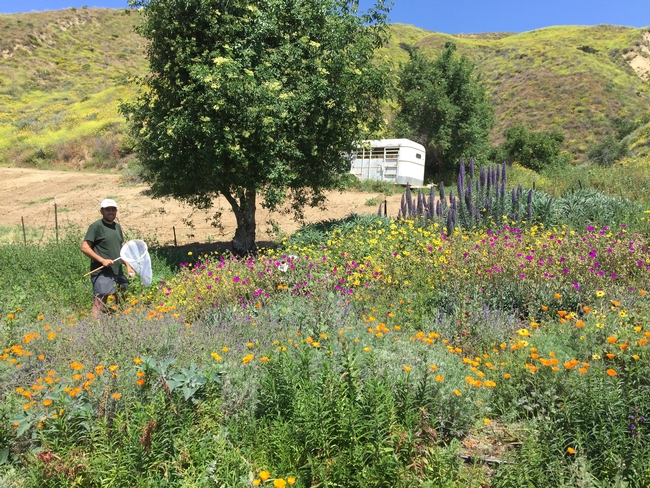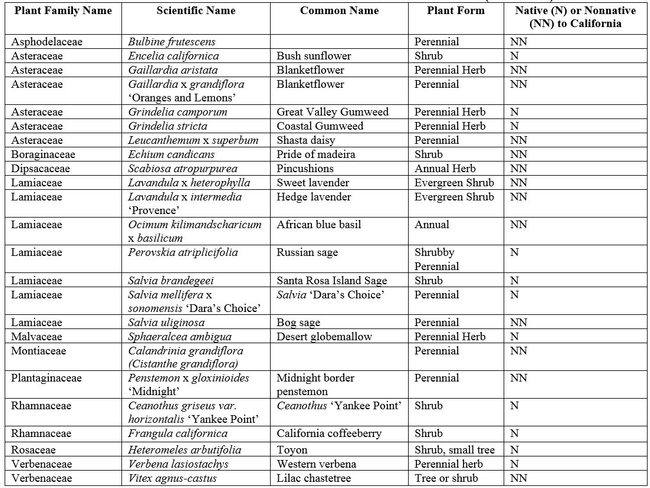Hedgerows are an approved practice under California Department of Agriculture's Healthy Soils Grant Program. That means, growers are eligible to receive grant funding for planting hedgerows. But what exactly are the benefits of hedgerows and why are they worth planting? As a perennial planting it can have immediate impacts on the soil, but what else? The answer lies large in the pollinators and beneficial insects they attract.
The most basic definition of a hedgerow is dense vegetation planted in a linear design. Perennial grasses, shrubs, and even short trees are all candidates for hedgerow plantings, provided they meet the conditions of the local climate and soil. Growers plant hedgerows to achieve one or more of the following desired outcomes:
- To increase habitat for pollinator and beneficial insect populations
- To create a living barrier or fence
- To reduce chemical drift or odor movement
- To intercept airborne particulate matter
- To act as a low windbreak or reduce dust
- To increase carbon storage in biomass and soils
- To provide food, shelter, and shade for aquatic organisms in nearby aquatic habitats
All of these benefits make the case for planting hedgerows on any agricultural operation. In Ventura County, avocado growers stand to see a compelling case for hedgerow plantings with particular attention to pollination services.

There are many different pollinators who visit avocado flowers, from native bees to flies to honey bees. Some come in the daytime, others visit at night. In the likelihood that honey bees and other pollinators will continue to decline, it is imperative to study the importance of native pollinators on key crops and identify ways to increase habitat for resident populations (NRC 2007; Nordhaus 2011; PHTF 2015; Koh et al. 2016; Sánchez-Bayo and Wyckhuys 2019; DiBartolomeis et al. 2019; Garibaldi et al. 2013). This information not only helps the pollinator populations thrive, but helps avocado growers acquire free increased pollination services for fruitful trees. Several researchers have published accounts of increased pollinator diversity and numbers in hedgerow and field edge planting studies across various agricultural systems (Heller et al. 2019; Long and Anderson 2010; Long et al. 2017; Williams et al. 2015).
In Ventura County, we are seeing some fascinating and relevant research around the impact of hedgerows on pollinators in avocado orchards. A collaborative research project involving Dr. Ben Faber, Avocado Advisor for UC Cooperative Extension Ventura County, and Dr. Gordon Frankie, professor and research entomologist at UC Berkeley and lead investigator of the UC Berkeley Urban Bee Lab, seeks to understand long-term impacts of hedgerows on pollinators of avocado trees. The project, which began in 2014 with three participating avocado ranches, has indicated increased pollinator activity, increased native bee populations, and increased diversity of species with the presence of hedgerow plantings (Frankie, Faber et al. 2020). The results indicate the importance of diversity of pollinator species, not just the honeybee, to avocados. In continuing this research, the team seeks to address the unanswered questions of which pollinators are the most effective at pollinating avocados and which are the most effective at influencing fruit set. A particularly exciting and novel aspect of this project is looking at whether or not there are nocturnal pollinators visiting California avocados. Nocturnal pollinators have been well documented in New Zealand (Pattemore et al, 2018), but none have been yet recorded in California avocados.
Maintaining hedgerows is critical to providing additional habitat for an abundance of pollinators. Creating and maintaining that hedgerow and for which pollinators can be a daunting task to embark on. Luckily for avocado growers, Dr. Frankie and Dr. Faber's team are working with Southern California growers to develop a pollinator garden manual. The manual will provide clear pictures of key pollinators and key plant species that pollinators are drawn to. Detailed imagery, descriptions, and maintenance tips will help make the decision making around planting a hedgerow much easier.
Speaking of selections, there are key plants that are drought-tolerant, easy to maintain, and well-suited for Ventura County's climate. See the table below for some ideas.
Table 1. Main Native Bee Plants Installed in Avocado Orchards 2014-2019
We seek to increase biodiversity, build soil health, and reduce energy use in our agricultural systems to improve our resiliency to climate change impacts, pests, and disease. To keep farming in our families and in our futures. Planting hedgerows is good for the pollinators, which is good for the bottom line and long-term success of the operation.
If you are an avocado grower interested in learning more about the pollinator research project, please contact Dr. Gordon Frankie at the UC Berkeley Urban Bee Lab gwfrankie@berkeley.edu.
Interested in planting hedgerows on your property? You may be able to qualify for a grant through CDFA's Healthy Soils Grant Program to plant hedgerows. Please contact Jamie Whiteford with the Ventura County Resource Conservation District at jamiewhiteford.vcrcd@gmail.comfor more information on how to apply. For those in other areas, Technical Assistance providers are able to discuss the values of hedgerows and funding opportunities for installing them in other agricultural situations: http://ciwr.ucanr.edu/Programs/ClimateSmartAg/TechnicalAssistanceProviders/

References Cited
DiBartolomeis, M., S. Kegley, P. Mineau, R. Radford, and K. Klein. 2019. An assessment of acute insecticide toxicity loading (AITL) of chemical pesticides used on agricultural land in the United States. PLoS ONE 14(8): e0220029. https://doi.org/10.1371/journal.pone.0220029.
Frankie, G., B. Faber, J. Pawelek, R. Thorp, R. Coville, C. Jadallah, E. Takele, S. I. Rios, T. Bean. 2020. Native Pollinators of California Avocado as Affected by Introduced Pollinator Gardens. International Society of Horticultural Sciences Congress. Acta Horticulturae.
Garibaldi, L.A., I. Steffan-Dewenter, R. Winfree, and 47 other authors. 2013. Wild pollinators enhance fruit set of crops regardless of honey bee abundance. Science 339:1608-1611.
Heller, S., N. K. Joshi, T. Leslie, E. G. Rajotte and D. J. Biddinger. 2019. Diversified Floral Resource Plantings Support Bee Communities after Apple Bloom in Commercial Orchards. Scientific Reports 9 Article number: 17232.
Koh, I., Lonsdorf, E. V., Williams, N. M., Brittain, C., Isaacs, R., Gibbs, J., Ricketts, T. H. 2016. Modeling the status, trends, and impacts of wild bee abundance in the United States. Proceedings of the National Academy of Sciences 113:140–145.
Long, R. F. and J. Anderson. 2010. Establishing Hedgerows on Farms in California. UC ANR Pub 8390, Oakland, CA. http://anrcatalog.ucanr.edu/Details.aspx?itemNo=8390
Long, R., K. Garbach and L. Morandin. 2017. Hedgerow benefits align with food production and sustainability goals. California Agriculture 71:117-119. 10.3733/ca.2017a0020.
NRC. 2007. Status of Pollinators in North America. National Research Council of the National Academies. National Academies Press, Washington, D.C.. 307 p.
Nordhaus, H. 2011. The Beekeeper's Lament. Harper Perennial, NY. 269p.
Pattemore, D., M. N. Buxton, B. T. Cutting, H. McBrydie, M. Goodwin, A. Dag. 2018. Low overnight temperatures associated with a delay in ‘Hass' avocado (Persea americana) female flower opening leading to nocturnal flowering. Journal of Pollination Ecology 23(14): 127-135.
PHTF: Pollinator Health Task Force. 2015. Pollinator Research Action Plan. The White House.
Sánchez-Bayo, F. and K. A. G. Wyckhuys. 2019. Worldwide decline of the entomofauna: A review of its drivers. Biological Conservation 232:8-27.
Williams, N. M., K. L. Ward, N. Pope, R. Isaacs, J. Wilson, E. A. May, J. Ellis, J. Daniels, A. Pence, K. Ullmann, and J. Peters. 2015. Native wildflower plantings support wild bee abundance and diversity in agricultural landscapes across the United States. Ecological Applications 25: 2119–2131

